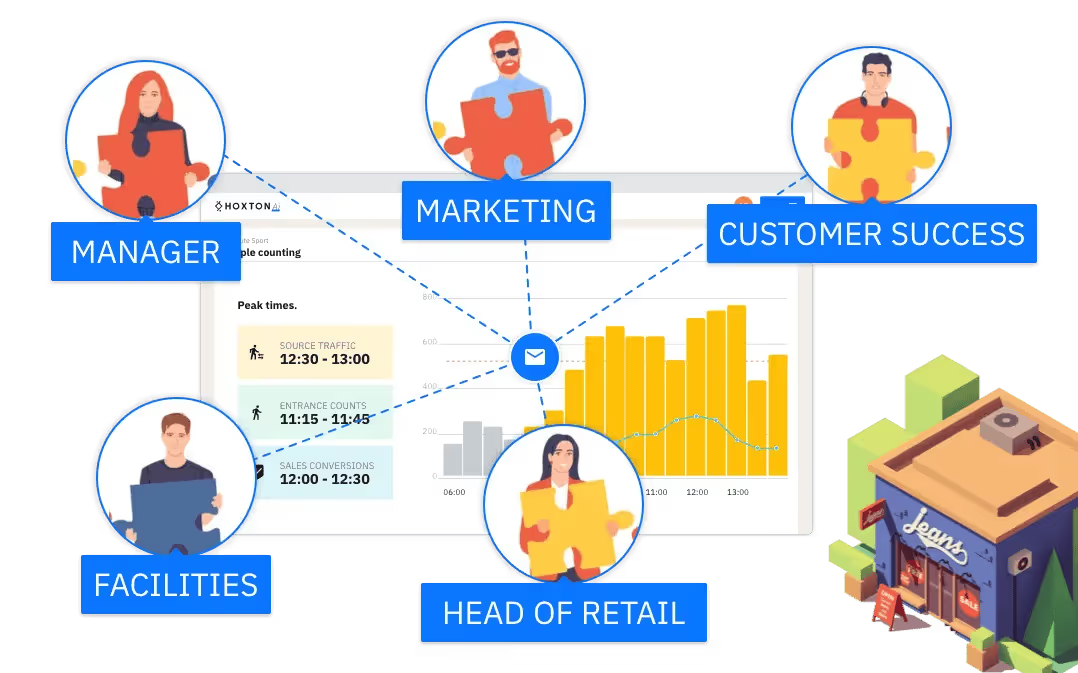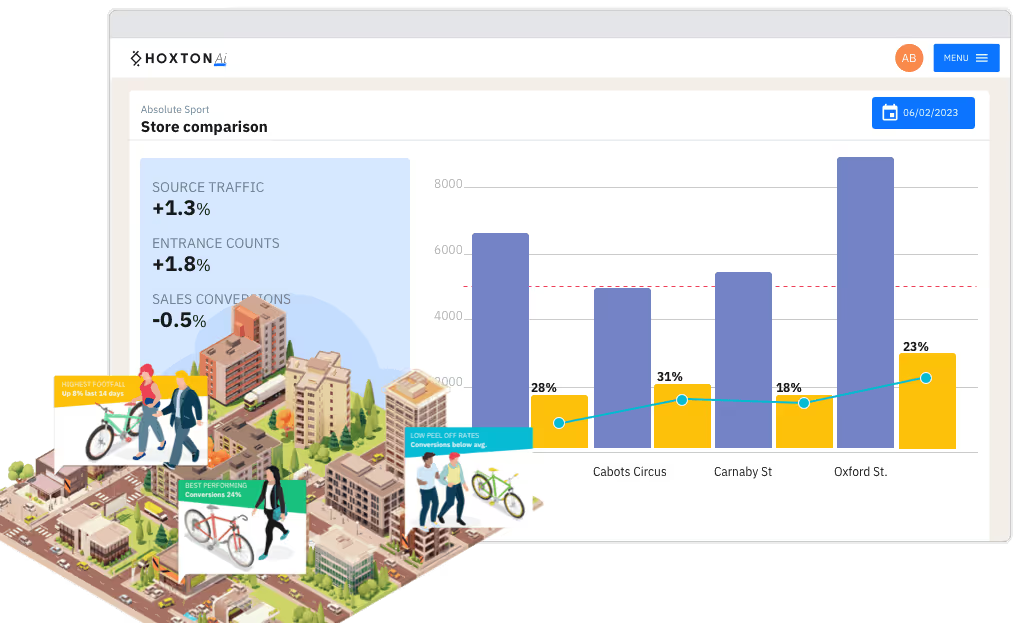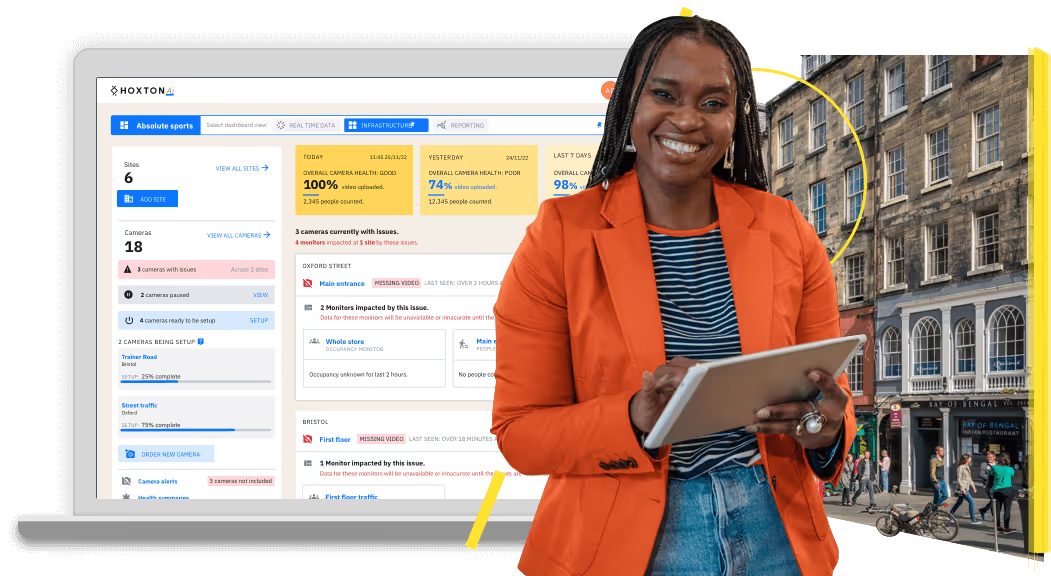As shoppers continue to return to the high street post-pandemic, physical stores need to catch up with their online counterparts by using customer data to increase satisfaction levels and drive sales.
How data helps retailers deliver.
Successful retailing has always been about understanding what the customer wants – and giving it to them. In the past, decisions to get the right merchandising, product mix and in-store placement were all made on the shop floor. These days, data is king and by learning lessons from online retailers about how to understand customer behaviour and adapt accordingly, physical stores can collect and use data to help identify best practices, improve customer satisfaction levels, reduce costs and increase sales.
Data has always been an important part of retailing and has driven trends. Seeking to gain an advantage, retailers have tried to stitch together data – patchy as it may have been – to determine customer preferences and to help forecast demand in the Christmas, Easter or summer seasons. Right up until well into the 1990s, payments were primarily in cash, stock control and forecasting were in their infancy, and the head offices of specialist and mid-market retailers operated from spreadsheets or even paper ledgers.
Since then, the retail world has changed. The success of online retailing has shown the power of analysing customer data to drive sales and, to be successful, physical stores need to follow suit.
The internet changed everything.
The internet has changed retailing forever, with consumers having unprecedented convenience and choice, direct access to all products on the market, easy price comparisons, home delivery and a variety of payment options including credit cards, Paypal, or more recently Buy Now Pay Later (BNPL) schemes.
Visionaries and market leaders such as Amazon, ASOS, and THG (formerly the Hut group), have overtaken the former titans of the high street using a key advantage; their detailed understanding of their customers’ purchasing behaviour. Online retail giants have built vast databases of purchasing histories, product searches which they use to better understand online behaviour as it relates to buying patterns. This gives them the insight to test and optimise their customer funnel, and with increased investment in ‘big data’, achieve higher rewards in marketing, conversion, merchandising and ultimately sales. The battleground has shifted for good and it is driven by customer data.
Data, the ultimate advantage
There are many factors that give online retailers a competitive advantage including lower operating costs, bigger product ranges and 24/7 operations. However, their ultimate advantage lies in the data that they are able to collect and analyse for each and every customer interaction. This enables them to take a far more sophisticated approach to measuring and understanding the entire customer journey – from who has visited their site, their areas of interest, which products they looked at, and, of course, what was ultimately purchased (or not). Indeed, insights into which products and ranges aren’t purchased can be just as valuable as data around top performing lines.
By comparison, physical retailers generally see only what was purchased without gaining any insight into how many people entered a store, which departments or areas of the store customers visited the most and which they missed. This leaves physical retailers with an incomplete picture of their customers’ behaviour, poor understanding of conversion rates and ultimately restricts their ability to improve the performance of their stores.
Giving physical retailers the ability to collect hard data from all of their stores, measuring, for example, footfall, the popularity of different departments at different times of day, and conversion rates for different product lines, enables them to accurately measure and compare the performance of each store across their entire retail estates. This provides detailed insight into how each store is performing and is incredibly powerful in determining best practice and achieving consistency across multiple branches.

The pandemic accelerated online…temporarily
There is no doubt that commentary on the retail industry has long been dominated by the demise of physical stores and the growth in online retail. No one can question the trend, further enhanced by the pandemic, that drove online sales at an even faster rate than had been previously predicted. Digital adoption strategies accelerated to deliver a transformation which, without the pandemic, may have taken a decade. According to McKinsey and Company, for example, e-commerce grew nearly five times faster in the UK in 2020 than before the pandemic (figures published March 2021).
The trend was clear – more and more people shopped online, and commentators at the time extrapolated this to forecast that soon all retail would be online. And who could argue? The numbers pointed in one direction: people wanted to shop online, and the high street was dead.
However, there were clearly extenuating factors behind this rapid growth in online shopping, not least of which was a succession of lockdowns. Since high streets have re-opened there has been a decline in the percentage of purchases made online and an increase in those made in-store. It turns out, many people like to visit the high street.
Recent growth in physical stores
The reality is that customers prefer a combination of physical and online shopping. According to KPMG research, one of the main reasons why consumers visit physical stores is to see, experience and test products in person before buying them. Often customers will go to a physical store to view a product and then order it online at a lower price. This emphasises the importance of a multi-channel approach and new retail success stories are emerging, combining online and offline, in a so called ‘phygital’ model. This requires existing retailers to adapt and use their physical presence in new ways, and is the reason why many online retailers are establishing a physical presence themselves.

Source: ONS Retail Sales Index, internet retail sales (January 2023)
The phygital model will be the key to retail success in the near future with the need for a physical presence - driven by customers wanting to know, feel, touch and discuss the product prior to making a purchase. Visits to the high street have also changed, with shopping viewed much more as a leisure activity combined with a visit to a café, lunch and going out with friends.
Growth in the online world has seen purchasing decisions often become simply a transactional relationship and a flight to the bottom, resulting in low margins for retailers. From the retailers’ point of view, PPC marketing can produce poor returns as customers shop around online for the best deal, so are loyal only to whoever is selling at the cheapest price. Physical stores give retailers the ability to elevate their offer above simply being the cheapest.
A key driver of the phygital model is using physical stores to interact with customers, build brand loyalty and demonstrate the qualities of their products. Stores will drive loyalty through branding and staff interactions and attract new customers through enticing window displays.
Physical stores are also likely to see a lower rate of product returns and, as both ASOS and Boohoo have demonstrated, a high rate of returns is costly to any retail business. For example, ASOS saw a share price drop of 15 percent, a 12 year low, in June 2022 due, in part, to its high rate of returns. Similarly, in May 2022, Boohoo saw its profit drop by 94% as online shoppers returned clothes at an increased rate. Return rates for customers buying in-store are much lower than for those buying online. Additionally, letting shoppers exchange or return in-store the items bought online can reduce the cost of returns by removing shipping and transportation fees.
Physical stores need to be managed as surgical, uncompromising and multifaceted assets, just as websites are. They are there to drive revenue but are costly to fit out and run, so hard data is needed to drive decisions that will maximise return on investment. For example, which is better for a business, a large investment in a flagship store in the West End, or ten stores in secondary locations?
Getting answers to questions like these shifts the battleground away from online and back to the high street.
Winners and losers
The true value of physical stores is in enabling retailers to build customer loyalty, gain better understanding of their customers, and roll out targeted programmes, promotions and personalised experiences based on real customer service rather than an algorithm.
Those that have successfully adapted have reaped the rewards. The big winners have distinct brands and an intimate understanding of their customers. Tesco has invested heavily in customer data with loyalty schemes and, as a result, has maintained its dominance. Marks and Spencer adapted, leaning into grocery and is now performing well. JD Sports’ progress is remarkable. It is the most valuable non-grocery retailer in the UK due to its branding, merchandising and commitment to a new kind of high street, where investment in technology aligns it with what millennial and Gen Z customers want. Retailers that have been unable to adapt have often fallen by the wayside. Woolworths, Debenhams and Maplin are examples where exposure to the high street and scattergun merchandising caused them to fail.
Successful retailers understand that customers are loyal to their favorite brands and embrace a multichannel approach. They adapt and use their presence on the high street to meet consumer expectations. From aggressive PPC marketing, click-and-collect options and large online catalogues, ‘multichannel’ is the key to making store estates work. However, where the shift to online has meant more information and data to optimise the customer funnel and experience, the rebound to physical presence provides a new challenge. Now dependent on sophisticated datasets, there is a black hole - a data gap – that needs to be addressed for physical retail.

Filling the data gap in physical stores
To fill the data gap, managers of physical stores need access to detailed customer data while they shop. The technology now exists for retailers to do exactly this and gain insight into customer behaviour in physical stores, akin to monitoring online customer activity, so that they can build a clear picture of how customers are behaving in each store across their retail estates.
By using people counter sensors linked to Artificial Intelligence-based occupancy monitoring, data is gathered and analysed to determine how physical stores are performing. The data collected in store is just as rich as in the online world, enabling customer behavior to be analysed and the in-store experience improved. Critically, when analysed across multiple stores, even small amounts of data become powerful in the insight that they provide.
With this technology, the entire in-store customer journey can now be analysed, starting with how many people come into each store, how many people go to each area, how many people make a purchase and, importantly, how this differs between branches.
Such insight enables data-driven operational decisions to be made and revenue streams to be improved, with accurate street-to-store conversion data, comparisons of site performance, accurate staff planning and clear measurement of marketing impact.
Combined with transactions and point of sale data, a more complete picture can be developed with specific metrics to clearly show how each store is performing:
- Comparing passing traffic across stores with the rent they are paying to assess value for money for the location they are investing in.
- The ‘capture rate’, the percentage of passing people that enter the store. Changes in this metric indicate the effectiveness of window displays, local marketing and sales events.
- The ‘conversion rate’, comparing the number of people entering the store with the number of transactions. Comparing over time and locations identifies where sales best practice is driving revenue growth. This best practice can be shared across stores, and the impact measured.
- The impact of changes in store layout and operation can be measured, much as changes to a website can be tested
Shopping as a customer experience
The retail world has changed. As shopping takes place across multiple channels and becomes increasingly digital, physical retailers now have to deliver more of an experience to entice customers.
Physical retail needs to complement online by providing more personalised experiences based on insight and understanding of customer interests. This requires a unified approach, built on a foundation of customer intelligence, gathered both on and offline.
Retailers of all sizes are waking up to the value using data gathered from different channels to enhance the customer experience by making stores as enticing as possible.
If you’re interested in learning how you can extract more meaningful data insights from your physical retail stores or would like a demo of our solution, please click here to get in touch.

%20(1).png)





